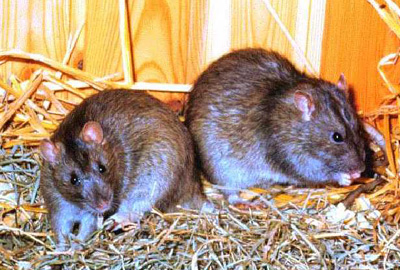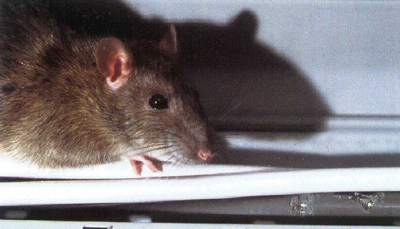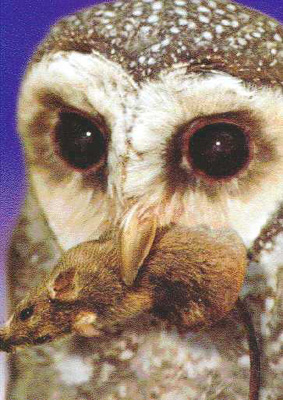 Click To Return To Main Page |
 |
||||||||
 News |
 Eco-Journalists |
 Articles |
 Games |
 Links |
 Facts 'n Fun |
 Email Us |
 About Us |
 Guestbook |
|
|
Rats in the Roof
Rats in their nest.
 Imagine lying in bed when you suddenly hear this insane noise that sounds like someone scratching on the floor of the attic to get out. Guess what? You have rodents. Not only that, but they're probably Ratus Ratus...remember the rat which spread the Bubonic Plague that nearly wiped out Europe...yup, that's the one! Ratus Ratus is the Latin or scientific name given to the 'roof rat'. This rat often lives in houses and is very clever at finding food left by humans.
Imagine lying in bed when you suddenly hear this insane noise that sounds like someone scratching on the floor of the attic to get out. Guess what? You have rodents. Not only that, but they're probably Ratus Ratus...remember the rat which spread the Bubonic Plague that nearly wiped out Europe...yup, that's the one! Ratus Ratus is the Latin or scientific name given to the 'roof rat'. This rat often lives in houses and is very clever at finding food left by humans.
The Roof Rat has a tail longer than its body. They can weigh up to 300 grams(just over a packet of butter) and about 16 to 22 cms in length. Each female can give birth to about 40 baby rats a year. A rat has to eat 15 grams of food a day and 15mL of water a day, but rats can go longer without water than a camel! Rats are omnivores (they eat both vegetables and meat). However, they mostly eat fruit, grain and cereals and will only nibble on insects if they have to. However, rats are also very shy creatures. So this means that you won't wake up in the morning to find a rat nibbling on your nose. The Roof Rat is a very good climber which means they can live up trees and are capable of climbing up pipes to get to your cosy house...eep! Rats chew through electrical wires which can cause fires.
 Rats have a reputation for being the spreader of diseases and I'm afraid this is true. Rats can carry over thirty different diseases which are dangerous to humans, including Weil's disease, typhus and bubonic plague. If you have rats in your roof, there is a good chance you could catch one of the diseases - including types of worms...yuk!
Rats have a reputation for being the spreader of diseases and I'm afraid this is true. Rats can carry over thirty different diseases which are dangerous to humans, including Weil's disease, typhus and bubonic plague. If you have rats in your roof, there is a good chance you could catch one of the diseases - including types of worms...yuk!
Rats cause many house fires each year because they chew electrical cables. Just think of all the damage those sharp teeth can do. Their front teeth grow constantly so they need to gnaw on things to wear them down otherwise they couldn't eat. Rats are nocturnal (they are active at night and sleep in the day). If you see a rat in the daytime it means there is an overpopulation of them in the local area. This is when you need to kill them off! 'How can I find out whether my house has a rodent problem?' I hear you say. Well, you can listen for gnawing, scratching and squeaking noises in your walls. You can put talcum powder down and later check for footprints. Also, you can look for rodent poo which is usually in small, longish pellets. You may find gnawing marks on wood or even where they have bundled-up roof insulation. Don't think that rats can't get into your roof...they only need a hole about 2cm wide to squeeze through. How to get rid of rats Make sure it really is rats and not possums. It may be worth hiring a possum cage to put in your roof first. You bait it with some fruit; the possum isn't hurt, it's just trapped in the cage. Once you're sure it's rats, you need either: Rat traps, or Poison. We had no luck using rat traps. They're dangerous and can chop your fingers off. Also, they didn't work. We baited them with peanut butter - Roof Rats like moist food - but they worked out how to lick it off the trap without setting the trap off. Did I say how clever rats are? Owls eat rats which is why you should
use a poison like Racumin  There are lots of different rat poisons that you can buy, but you want to make sure that it's as environmentally friendly as possible (except to the rats - which, let's remember, are an introduced species). Planet Patrol recommends 'Racumin'.
There are lots of different rat poisons that you can buy, but you want to make sure that it's as environmentally friendly as possible (except to the rats - which, let's remember, are an introduced species). Planet Patrol recommends 'Racumin'.
Firstly, some of the rat poisons for sale use Bromulin which rats are now resistant to. Racumin uses a newly developed poison which not only kills the rats, but also breaks down quickly in the rat's body. This means that there is much less chance of animals such as owls getting poisoned and dying if they ate the rat. (Owls are the natural predator of rats). When they see a slow, sick rat that is easy to catch they immediately eat it. This means that they also eat the rat poison which kills them. Apart from owls being gorgeous birds, a decrease in the owl population means that the rodent numbers will rise as there's not enough owls to eat them. If you want to find out more about 'Racumin,' visit: www.owlsonfarm.com.au Did you know that up to 1/3 of the World's food crop is eaten or spoiled by rodents? TIPS FOR USING RAT POISON! - always wear protective clothing and gloves. - follow the instructions on the packet closely - put plenty of poison down, fix the Racumin to something so the rats are forced to eat it otherwise they'll try to drag it off to store in their nest. - make sure there's no sunflower seeds etc put out nearby for birds....the seeds contain Vitamin K which is an antidote to rat poison! - don't leave food out for dogs and cats as it's an easy meal for the rats. By Imogen Wadlow
A big thank you to Phil Mead from Bayer for the information about Racumin and especially for the funny story about his friend's guinea pig which turned out to be a rat which he'd been feeding (I told you they were clever!).
Information sourced from: www.bayer.com.au http://en.wikipedia.org/wiki/Rat www.nsrl.ttu.edu/tmot1/rattratt.htm |